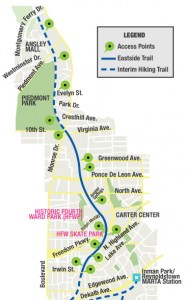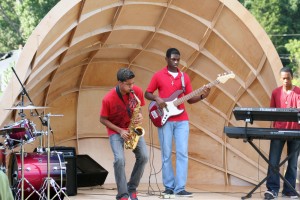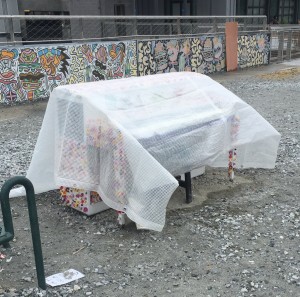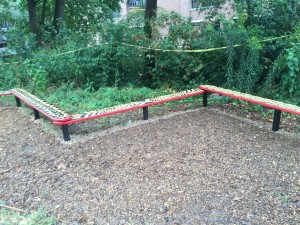We had a short discussion of benches when we looked at my first collage of artifacts, so naturally, I was on the lookout for another one. This one resembles something out of the Flintstones. It has curvy wood separated by three points by large stone circles. Going back to our classroom discussion, we talked about how benches are often made thinner to prevent homeless people from sleeping on them. For this bench, it is definitely slim, and the curves would prevent someone sleeping even more. As usual, I hope that this is simply an artistic choice.
Tag Archives: Sculpture
Built Environment Description 1: Art on the Eastside Beltline

Map of the Eastside Beltline
The Beltline started as a thesis by a Georgia Tech student, later turned into a grassroots political movement, and today serves as a cultural epicenter and a hallmark of civic pride. The first section of the Beltline, the Eastside, opened as recently as 2012, yet it already possesses a dazzling richness of art. In many ways, walking down the Beltline feels like walking through the world’s most unique art museum.

One of many benches
Along the Beltline, you will see sculptures most often, and they take a beautiful myriad of forms, few of them the familiar classic form (you will find no Roman emperors here). The sculptures that you will see resemble structures, people, bicycles, and more. Some you will struggle to see because they barely rise above the unmolested grass, while others tower above you. Several sculptures have for backgrounds bright skies, yet many have gray walls. Interestingly, some pieces double as benches, beautiful to look at and comfortable to sit on. Some artists designed sculptures that act as gates and landmarks, notifying walkers of exits. Like the Beltline itself, the sculptures blend aesthetic and utility in remarkable ways.
The environment creates less space for painting,but artists persist. Below bridges, painters have walled the tunnels with expansive murals, like a beautiful form of street art or graffiti. Again looking at the mix of practicality and beauty, stores along the trail have added paintings on the backs of their stores that symbolize and inform what services they provide.

Band performing on a sunnier day
Sadly, I cannot yet comment on the music on the Beltline because the rain drove musicians away. I found only one performer, a singer and guitarist, during my walk, using a bridge for protection. I passed by a piano covered in flowers from the Pianos for Peace project, but someone had covered it to shield from the rain.
Of all the distinctions, perhaps the greatest difference from an ordinary museum was the clientele. Though undoubtedly less busy than a usual day (again, the rain’s fault), people still flocked to the path. The visitors included joggers and bikers exercising and gasping for breath, friends dressed in nice Sunday clothes strolling and chatting, and families walking and biking. Most striking to me, some folks only used the trail to walk from their homes to buy groceries. It is hard to imagine that another art museum covered in a plethora of sculptural forms, lined with grand canvases, capped off with trees and skylines, a place equally for families, runners, and church-goers, and usable as a route to daily errands exists anywhere else in the world.
(All pictures taken by me or the Atlanta Beltline official website)
Nature’s Way
Everything feels like art along the Beltline, and the art present does not limit itself to sculptures and murals, even the benches are something special. Pictured above is one of those benches. This bench, titled “Nature’s Way,” is situated in a small clearing, backdropped by trees and an apartment complex. Rather than being completely straight, the structure zig-zags several times, and the surfaces feature different patterns of yellow and black that symbolize scenes like flowers and farming fields. Of course, you can also sit on the bench, not just look at it.
Skater Sculpture on the Beltine
Quickly after entering the Beltline, I found my first piece of art (and would later be stunned by the quantity present): a sculpture, in the image above. In short, the sculpture shows a skateboarder, standing several feet taller than the people passing by. Both the skateboard and skateboarder are constructed out of typical piping, red for the rider and blue for the board, with skateboard wheels that look like little car tires.





